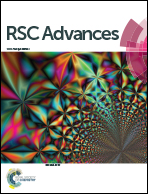Fluorescence amplification detection via terminal protection of small molecule–protein interactions†
Abstract
A novel fluorescence assay strategy has been developed for quantitatively detecting small molecule–protein interactions on the basis of terminal protection. It is well-known that β-indole acetic acid (IAA) is a critical plant hormone molecule regulating plant growth. This terminal protection strategy was demonstrated using IAA and its binding protein anti-IAA antibody as a model case. The IAA-labeled strand of the double-stranded DNA (dsDNA) is protected from degradation by T7 exonuclease when the small molecule moiety is bound to its antibody. By using a competitive assay format, this developed method shows that the fluorescence peaks are dynamically correlated to the concentrations of IAA ranging from 1 to 2000 nM with a detection limit of 0.4 nM. Our assay strategy is able to offer high selectivity, excellent reproducibility, cost-effective, and simplified operations.


 Please wait while we load your content...
Please wait while we load your content...